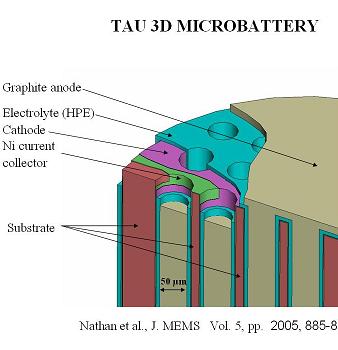An innovative lithium-ion nanobattery technology developed at Tel Aviv University promises to provide an alternative energy source for portable electronic devices such as laptops, without the fire hazard found in existing lithium batteries.
Tel Aviv University

The battery technology of the last decade does not keep pace with the developments of semiconductor technologies and electronic devices. As a result, batteries have become the weak link in the operation of portable electronic devices such as cell phones and laptops. The rate of increase in the power consumption of these devices requires the battery manufacturers to significantly increase the lifespan of the batteries by cramming more and more power (or electrical capacity) into smaller and smaller packs. In addition, users are becoming impatient with the charging time required by high-capacity batteries, so the design of batteries that charge faster is required.
These two requirements - high power and high charging speed - led to the development of batteries with lithium that operate at relatively high temperatures and are exposed to the risk of fire (flammability). When lithium-ion batteries overheat, they can ignite and pose a real danger to users. Only recently, Dell, one of the largest computer manufacturers in the US, as well as Apple, were required to recall millions of portable computers from consumers due to several cases of inflammation that broke out in their SONY batteries.
The innovative nano-battery technology, which may greatly reduce the risk of fire, was developed by the research groups of Prof. Menachem Natan from the School of Electrical Engineering in the Ivy and Alder Fleishman Faculty of Engineering and Professors Emmanuel Peled and Dina Golodnitsky from the School of Chemistry in the Raymond Weberly Faculty of Exact Sciences. Sackler, at Tel Aviv University. The technology provides batteries built from a large number (about 30.000 per square centimeter) of batteries the thickness of a human hair connected in parallel. This architecture can provide a large amount of electrical capacity without the risk of overheating.
Professors Natan, Peled and Golodnitsky developed a solution that combines the low resistance properties of batteries made of thin layers and the large capacity of ordinary lithium-based rechargeable batteries. Tens of thousands of miniaturized lithium batteries are produced simultaneously inside a substrate (for example - silicon) with a thickness of half a millimeter, using sophisticated and innovative coating technologies. The use of the substrate volume itself results in a considerable increase of the charge capacity per unit of substrate area, up to about 10 milliampere hours per square centimeter, more than 80 times more than normal batteries of thin layers with the same cathode thickness. Arrays of the nanobatteries described above were built and tested in the laboratory for hundreds of charge/discharge cycles, without capacity and stability processing.
Tel Aviv University's nanobattery technology is covered by a large number of patents in different countries. The technology is available for licensing through Ramot Lid Tel Aviv University, the university's technology commercialization arm.
